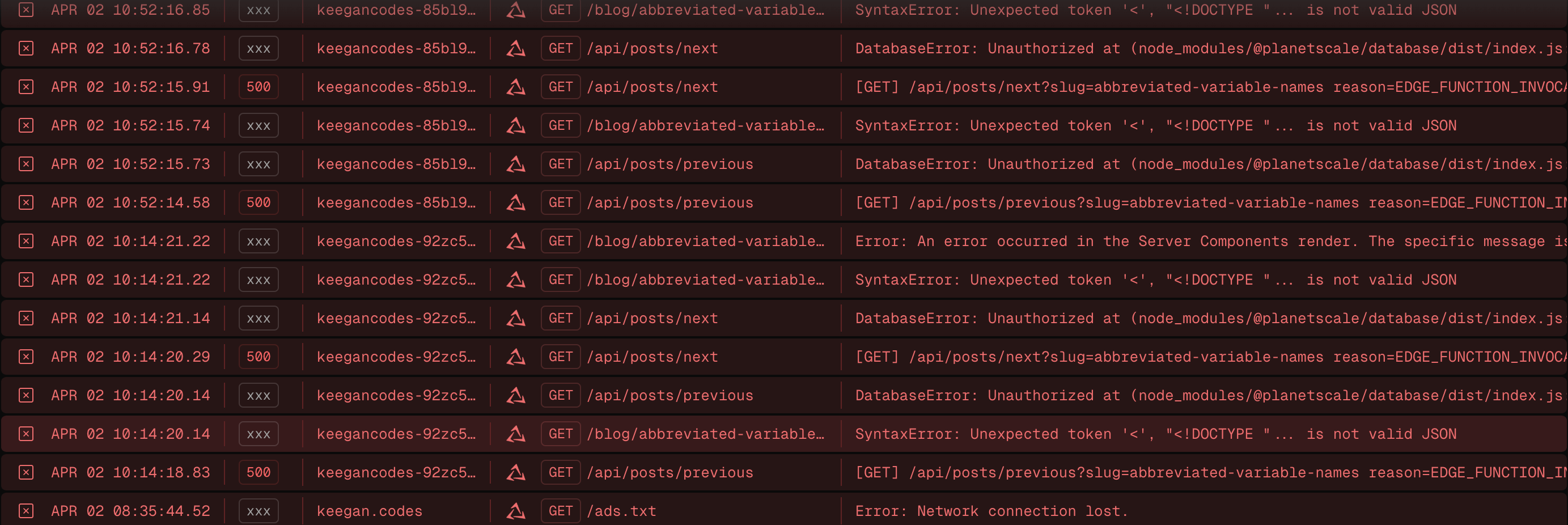How to Use Vercel Deployment Protection with Next.js RSC
Vercel provides a number of ways to protect your deployments from the public internet. One of them is called Vercel Authentication, which allows you to restrict access to all deployments except for the current production deployment. When enabled, you and any team members will need to log in to Vercel in order to access any past production deplyments, or any preview deployments.
This means that your preview and non-production deployments (including API routes) will require an authentication cookie to grant access. This will be important later when moving to this approach for an existing Next app.
This Next.js app for keegan.codes was not originally built with standard protection enabled, so I had to follow Vercel's migration guide in order to get everything working before I could turn it on. In this post, I'm going to cover what I learned migrating to this new protection, so you don't have to take as much time as I did trying to get data fetching to work with both server and client components using the same code.
Why Standard Protection?
Because this site is entirely open source, on the surface, protecting preview and past deployments doesn't seem necessary. All my code and content, including in-progress pull requests, are already public, which is why I didn't worry about it at first. However, something started happening recently where I began getting a ton of traffic to past deployment URLs. I'm not sure why; likely some bots/crawlers discovered some deployment URLs and started hitting them with requests.
Since I cycle my database keys periodically, old deployments eventually stop working because they were built with old environment variables. This means that whoever was using my old deployment URLs recently started causing my error logs to fill up, potentially masking real issues and leading to error fatigue:

Vercel does also have an option to only protect preview deployments, but that wouldn't solve all my issues. Instead, turning on standard protection blocks access to all my past deployments, so nobody can visit a version of the site with old, deactivated credentials.
Migrating
In order to turn on standard protection, you can no longer use the environment variables VERCEL_URL or NEXT_PUBLIC_VERCEL_URL.
This was my main hurdle to turning on deployment protection, because I use those variables extensively. I had a function for building
fetch URLs that worked both server-side and on the client:
export const getFullyQualifiedUrl = (path: `/${string}`) => {
if (process.env.NODE_ENV === 'development') {
return `http://localhost:${process.env.PORT}${path}`;
}
const domain =
process.env.VERCEL_URL ||
process.env.NEXT_PUBLIC_VERCEL_URL ||
'keegan.codes';
return `https://${domain}${path}`;
};
typescript
VERCEL_URLis only available on the server, andNEXT_PUBLIC_VERCEL_URLis available on the client. This function could be called either on the server or the client, and I didn't have to worry about how it was used.
When using standard protection, this approach won't work. In Vercel's migration guide, they inidcate that client-side requests need to be
relative urls, like /api/views, and server-side requests need to read the host from the request, and use that to build the fully qualified
URL. Additionally, server requests need to take the request cookies and pass them through to any API calls, since users will now need to be authenticated
in order to use the deployment.
Here's a new server component request function that satisfies this for fetching from server components:
export const makeServerRequest = (path: `/${string}`) => {
// Don't need anything special in local dev
if (process.env.NODE_ENV === 'development') {
return fetch(`http://localhost:${process.env.PORT}${path}`);
}
const headersList = headers();
const host = headersList.get('host') || 'keegan.codes';
const cookie = headersList.get('cookie');
const headers = cookie ? { cookie } : undefined;
return fetch(`https://${host}${path}`, { headers });
};
typescriptI'm getting the host from the request headers, and using that to build the request URL. This way, preview deployments will request their own version of the endpoint, not the production one. If I just set the host to
https://keegan.codesalways, I'd never be able to test new or updated endpoints in preview builds.
Requests made client-side don't need anything special, other than switching to be relative URLs. This works fine when I know an API will be called from the client, but that's not always the case.
Sharing Code Between Client and Server
This is all great, and works perfectly, unless you have a component that is sometimes a server
component, and sometimes a client component. When you're viewing my blog page, the first page
of posts is server-rendered, and then the infinite scrolling kicks in, and subsequent pages are fetched
client-side and rendered on the client as you scroll. Both approaches use the same component to render the view count, with the same
call to getFullyQualifiedUrl. However, if I add the headers() call to that function, it will fail to build
because that's only a server-side feature. How can one function to get the URL work in both situations?
First, we have to know if the function is being called on the server or not. That's actually pretty straightforward:
if (typeof window === 'undefined') {
// server
} else {
// client
}
javascriptUsing the knowledge of where the code is running, a dynamic import allows next/headers to only be imported on the server.
A new function can be created, getRequestUrl, that works in both scenarios:
// Just a simple helper to parse the host value
const getUrlFromHost = (host: string | null, path?: `/${string}`) => {
if (host?.includes('localhost')) {
return `http://${host}${path}`;
}
return `https://${host}${path}`;
};
const getRequestUrl = async (path: `/${string}`) => {
// Nothing special needed in development
if (process.env.NODE_ENV === 'development') {
const port = process.env.PORT || '3000';
return { url: `http://localhost:${port}${path}` };
}
let host = null;
let cookie;
// If on the server...
if (typeof window === 'undefined') {
// Dynamically import next/headers and retrieve the required values
const getHeaders = (await import('next/headers')).headers;
const headersList = getHeaders();
host = headersList.get('host') || 'keegan.codes';
cookie = headersList.get('cookie');
}
return {
// If we have a host, return a fully qualified URL, otherwise, a relative one
url: host ? getUrlFromHost(host, path) : path,
// Return a headers object if we are on the server and got cookies
headers: cookie ? { cookie } : undefined,
};
};
typescriptNow, no matter if we're rendering on the server or the client, fetch is always called the same way:
const { url, headers } = await getRequestUrl(`/api/do/the/thing`);
const data = await fetch(url, {
headers,
});
typescriptNote that we now have to
awaitthe call to get our url, because it might need to dynamically importnext/headersfirst.
Conclusion
This solution has been working well for me, and I finally have deployment protection turned on! Hopefully this approach will save you some time and you won't have to spend as much time as I did understanding how server and client components need to call APIs with deployment protection enabled!
You can read the full documentation on Vercel and continue learning about deployment protection, with how to allow automated tests to bypass it.


